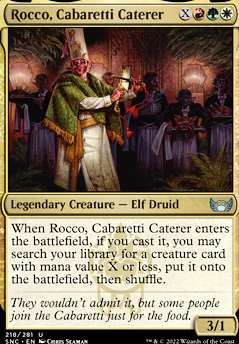
Rocco’s Silver Bullets [Casual Hatebears Primer]
Commander / EDH Control Hatebears Prison RGW (Naya) Stax Toolbox
Lands (39)
- 1x Battlefield Forge
- 1x Brushland
- 1x Cabaretti Courtyard
- 1x Canopy Vista
- 1x Cinder Glade
- 1x Command Tower
- 1x Copperline Gorge
- 1x Evolving Wilds
- 1x Exotic Orchard
- 5x Forest
- 1x Fortified Village
- 1x Game Trail
- 1x Jungle Shrine
- 1x Karplusan Forest
- 1x Kessig Wolf Run
- 1x Monumental Henge
- 2x Mountain
- 4x Plains
- 1x Radiant Grove
- 1x Razorverge Thicket
- 1x Rockfall Vale
- 1x Rugged Prairie
- 1x Sacred Peaks
- 1x Sanctum of Eternity
- 1x Shatterskull Smashing Flip
- 1x Sheltering Landscape
- 1x Temple of Triumph
- 1x Terramorphic Expanse
- 1x Witch Enchanter Flip
- 1x Wooded Ridgeline
- 1x Eagles of the North
Cards (5)
Ramp (14)
- 1x Avacyn's Pilgrim
- 1x Carpet of Flowers
- 1x Elvish Mystic
- 1x Llanowar Elves
- 1x Sol Ring
- 1x Wild Growth
- 1x Armored Scrapgorger
- 1x Farseek
- 1x Gala Greeters
- 1x Priest of Titania
- 1x Cultivate
- 1x Huatli, Poet of Unity Flip
- 1x Relic of Legends
- 1x The Restoration of Eiganjo Flip
Slowers (11)
- 1x Gaddock Teeg
- 1x Kataki, War's Wage
- 1x Thalia, Guardian of Thraben
- 1x Archon of Emeria
- 1x Kutzil, Malamet Exemplar
- 1x Thalia, Heretic Cathar
- 1x Magus of the Moat
- 1x Sunspine Lynx
- 1x Windborn Muse
- 1x Yasharn, Implacable Earth
- 1x Ruric Thar, the Unbowed
Finishers (6)
- 1x Adeline, Resplendent Cathar
- 1x Jetmir, Nexus of Revels
- 1x Aurelia, the Law Above
- 1x Etali, Primal Conqueror Flip
- 1x End-Raze Forerunners
- 1x Kamahl, Heart of Krosa
Bouncers (3)
Commander (1)
Misc Tools (12)
- 1x Deflecting Swat
- 1x Flare of Fortitude
- 1x Spore Frog
- 1x Hajar, Loyal Bodyguard
- 1x Lightning Greaves
- 1x Selfless Spirit
- 1x Eternal Witness
- 1x Hornet Nest
- 1x Sevinne's Reclamation
- 1x Timeless Witness
- 1x Yeva, Nature's Herald
- 1x Sun Titan
Removal (9)
Maybeboard
Ramp (14)
- 1x Avacyn's Pilgrim
- 1x Elvish Mystic
- 1x Fyndhorn Elves
- 1x Gilded Goose
- 1x Tinder Wall
- 1x Utopia Sprawl
- 1x Deep Gnome Terramancer
- 1x Goblin Anarchomancer
- 1x Priest of Titania
- 1x Circle of Dreams Druid
- 1x Faeburrow Elder
- 1x Llanowar Tribe
- 1x Llanowar Visionary
- 1x Karametra's Acolyte
Removal (8)
- 1x Dawnbringer Cleric
- 1x Lion Sash
- 1x Beast Within
- 1x Cemetery Prowler
- 1x Generous Gift
- 1x Angel of Finality
- 1x Silklash Spider
- 1x Archon of Valor's Reach
Cards (2)
Bouncers (13)
- 1x Nurturing Pixie
- 1x Scapegoat
- 1x Shepherd of the Flock
- 1x You're Ambushed on the Road
- 1x Horned Kavu
- 1x Kor Skyfisher
- 1x Essence Reliquary
- 1x Getaway Car
- 1x Blood Clock
- 1x Erratic Portal
- 1x Stampeding Serow
- 1x Stampeding Wildebeests
- 1x Umbilicus
Misc Tools (5)
- 1x Selfless Savior
- 1x Melira, the Living Cure
-
1x
Marisi, Breaker of the Coil

-
1x
Baeloth Barrityl, Entertainer

- 1x Gandalf the White
Finishers (3)
Suggestions
Updates Add
Comments
Attention! Complete Comment Tutorial! This annoying message will go away once you do!
Important! Formatting tips — Comment Tutorial — markdown syntax
Please login to comment
| Date added | 6 months |
| Last updated | 2 months |
| Legality | This deck is Commander / EDH legal. |
| Rarity (main - side) | 6 - 0 Mythic Rares 49 - 0 Rares 18 - 0 Uncommons 15 - 0 Commons |
| Cards | 100 |
| Avg. CMC | 2.80 |
| Tokens | Beast 3/3 G, Dinosaur 3/3 G w/ Trample, Human 1/1 W, Illusion */* U, Insect 1/1 G w/ Flying, Deathtouch, Spirit 1/1 C, Timeless Witness 4/4 B, Treasure |
| Votes | |
| Ignored suggestions | |
| Shared with | |
| Views |
